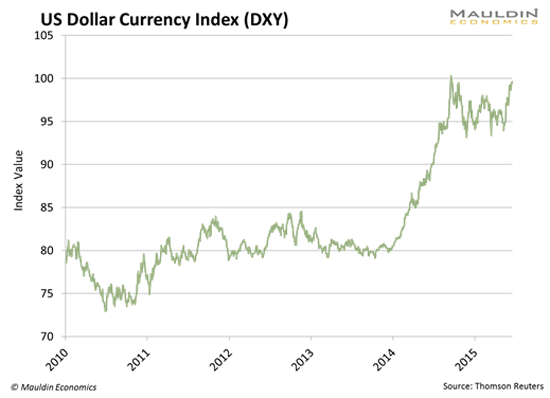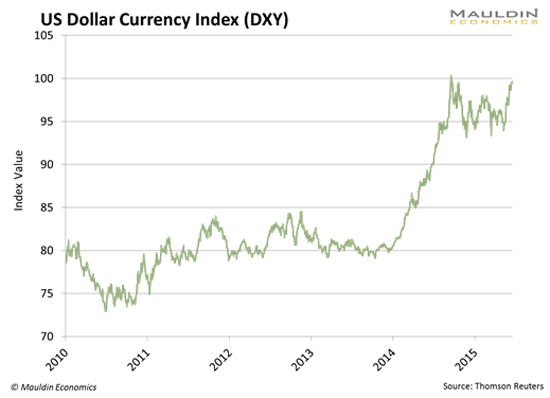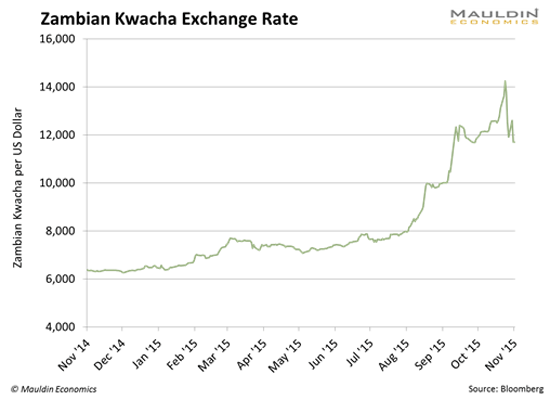This chart…

…is driving everything in the financial markets right now.
The Curious Case of Zambia
If you can’t see where I’m going with this, just give it a minute.
I’m fully aware that many people might be unable to find Zambia on a map, so here is Zambia on a map:

A few years ago, Zambia accessed the capital markets and did a dollar bond deal at an incredible 5.625%. People said at the time that the emerging/frontier trade was getting goofy. I disagreed. I thought Zambia was a better credit than, say, Italy.
It hasn’t worked out that way…

As you can see, the yield on that bond has gone from 6% to 11%, just in the last year.
Whoops.
Zambia found itself in a position where it had to issue more debt, at much higher interest rates. It had a huge budget deficit, because the government gets a huge amount of revenues from royalties on…copper mining.
Whoops.

And the reason copper is tanking is because China is in recession, and because of the chart I showed you at the beginning of this essay.

So why is the dollar going up?
Because even though the Fed hasn’t raised rates yet, relative to everyone else, the United States is actually sort of tightening its monetary policy.
When the Fed declined to raise interest rates because of “international concerns,” this is what they were talking about. Zambia, and everyone else like them.
For once, it is actually not Zambia’s fault. They were trucking along, growing at about 6.5% a year, and then a piano fell on their head. They were confident enough in their growth that they thought they would be able to issue dollar bonds.
You know what the problem with dollar bonds is: If your currency goes down, you are screwed.

Zambia was once a frontier-markets darling. No more.
But nothing has changed within Zambia. Same people. Same natural resources. Same government. Same thesis. They just got caught up in the macro s---storm.
Hold that thought.
A Just World
A just world is not one in which innocent third parties get mangled by developed-country economics. But that is what’s happening.
When a big macro/FX trend changes, there’s a lot of pain.
I heard about some research on this. Apparently, when you go from one FX regime to another, there is a period of adjustment that lasts about a year or two, then things start to get better as people get used to it. Lots of people think copper will turn around when the dollar falls.
Maybe not!
Maybe copper will go up when it’s just done going down, and base metals and the dollar will learn to coexist.
One thing I’ve learned about markets over the years is that they have a pretty good sense of karma. In the long run, people get what’s coming to them. Top of the list is Greece. Silicon Valley will have its turn in the barrel someday. I think it is already starting—hearing about private valuations dropping. And of course, the Canadians. Eventually, the markets catch on and will punish excess.
Zambia is hardly a symbol of excess, though. To the extent that it benefited from frontier portfolio flows, it wasn’t very much.
If you want to talk about excess, a lot of people have made a lot of money shorting miners. The market sure is taking its time getting around to redistributing bad fortune.
The Five-Year Plan
It’s pretty rare that bear markets last longer than two to three years. Even the really bad ones.
Crash/Great Depression: 1929-1932
Dot-com: 2000-2003
Financial crisis: 2007-2009
The metals bear market started in early 2011, so we are coming up on five years now.
I actually remember early adopters showing up to the short EM trade when I was still at Lehman. Seven years ago.
This has gone on long enough that I’m sure there is a whole cohort of young traders who think mining companies only go down. I, too, was born in a bear market.
Two things could potentially turn the metals market around:
- Fed chickens out
- China massively eases monetary policy, rallies
I think the second one is quite possible, and you never know with the Fed.
Or maybe the bear market just gets down to tag ends on its own.
You know, in the dot-com bust, there were literally hundreds of tech stocks that were down 95-99% from the highs. Those turned out to be great trades—at least the ones that didn’t go out of business. But it’s a dangerous game. If you buy something that’s down 98% and then it ends up down 99%, you just lost 50%.
The math behind this explains why bear markets just go on forever.

Jared Dillian
If you enjoyed Jared's article, you can sign up for The 10th Man, a free weekly letter, at mauldineconomics.com. Follow Jared on Twitter @dailydirtnap

